Terrorism: A Criminological Analysis of Patterns and Social Constructs
VerifiedAdded on 2023/02/01
|9
|2068
|21
Essay
AI Summary
This essay provides a comprehensive overview of terrorism, delving into its key features, patterns, and the social constructs that shape its perception. It examines the evolution of terrorism, highlighting events like the 9/11 attack and the role of media in disseminating information. The paper explores the characteristics of terror attacks, differentiating them from criminal victimisation and emphasising the political and ideological objectives. It critiques the mischaracterisation of terrorism as solely Islamic, presenting a balanced view of the diverse actors involved. The essay analyses patterns of terrorism, including the use of violence to instil fear and achieve political goals, and the triangular relationship between terrorists, targets, and objectives. It also addresses the social construction of terrorism, examining how legal, political, and media influences impact its definition. Furthermore, the essay discusses social responses to terrorism, including the stigmatisation of Muslims and the impact of counter-terrorism measures on human rights. The paper concludes with recommendations for addressing the issue, advocating for a focus on formalism, integrity, and non-discrimination to combat terrorism effectively.
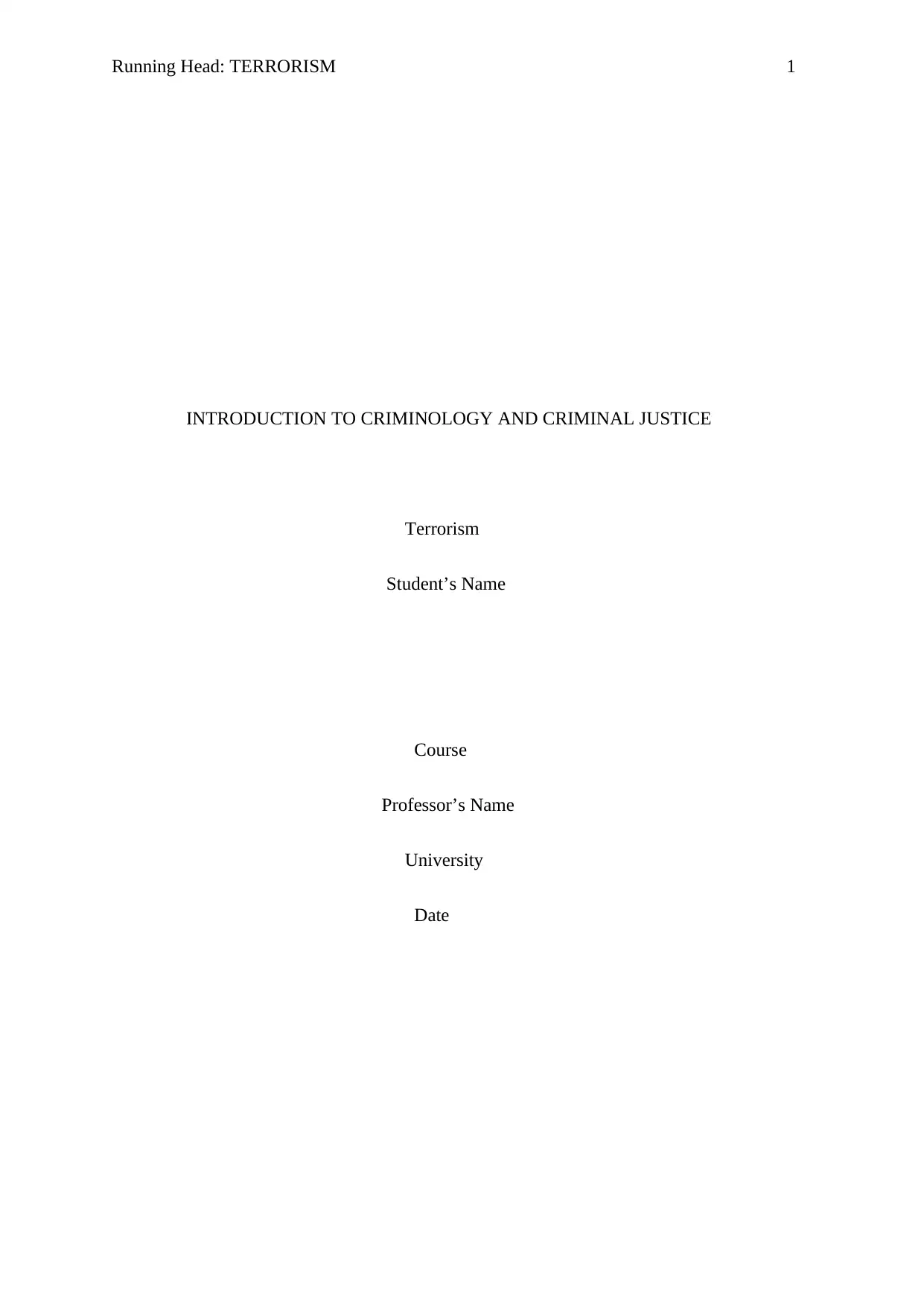
Running Head: TERRORISM 1
INTRODUCTION TO CRIMINOLOGY AND CRIMINAL JUSTICE
Terrorism
Student’s Name
Course
Professor’s Name
University
Date
INTRODUCTION TO CRIMINOLOGY AND CRIMINAL JUSTICE
Terrorism
Student’s Name
Course
Professor’s Name
University
Date
Paraphrase This Document
Need a fresh take? Get an instant paraphrase of this document with our AI Paraphraser
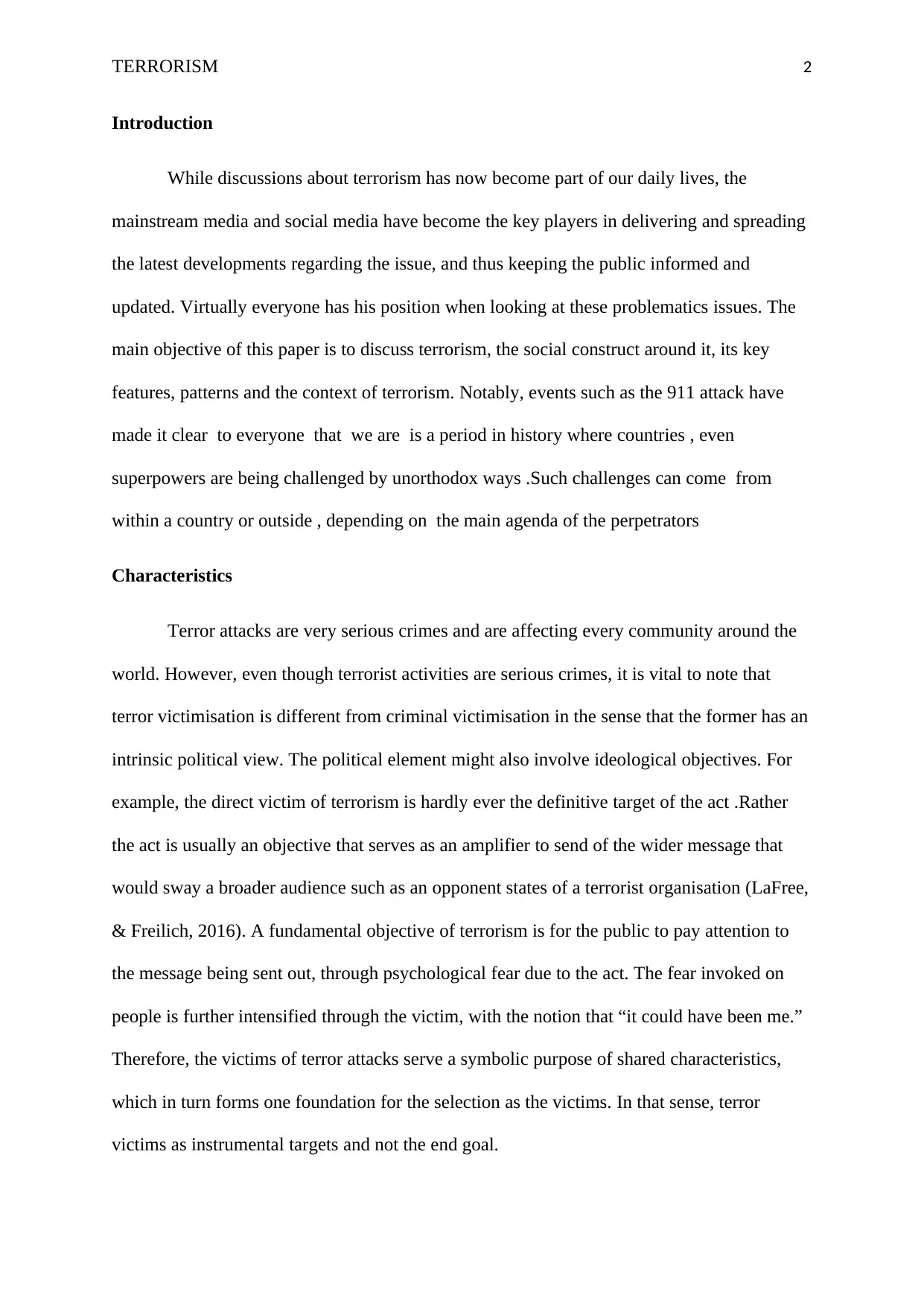
TERRORISM 2
Introduction
While discussions about terrorism has now become part of our daily lives, the
mainstream media and social media have become the key players in delivering and spreading
the latest developments regarding the issue, and thus keeping the public informed and
updated. Virtually everyone has his position when looking at these problematics issues. The
main objective of this paper is to discuss terrorism, the social construct around it, its key
features, patterns and the context of terrorism. Notably, events such as the 911 attack have
made it clear to everyone that we are is a period in history where countries , even
superpowers are being challenged by unorthodox ways .Such challenges can come from
within a country or outside , depending on the main agenda of the perpetrators
Characteristics
Terror attacks are very serious crimes and are affecting every community around the
world. However, even though terrorist activities are serious crimes, it is vital to note that
terror victimisation is different from criminal victimisation in the sense that the former has an
intrinsic political view. The political element might also involve ideological objectives. For
example, the direct victim of terrorism is hardly ever the definitive target of the act .Rather
the act is usually an objective that serves as an amplifier to send of the wider message that
would sway a broader audience such as an opponent states of a terrorist organisation (LaFree,
& Freilich, 2016). A fundamental objective of terrorism is for the public to pay attention to
the message being sent out, through psychological fear due to the act. The fear invoked on
people is further intensified through the victim, with the notion that “it could have been me.”
Therefore, the victims of terror attacks serve a symbolic purpose of shared characteristics,
which in turn forms one foundation for the selection as the victims. In that sense, terror
victims as instrumental targets and not the end goal.
Introduction
While discussions about terrorism has now become part of our daily lives, the
mainstream media and social media have become the key players in delivering and spreading
the latest developments regarding the issue, and thus keeping the public informed and
updated. Virtually everyone has his position when looking at these problematics issues. The
main objective of this paper is to discuss terrorism, the social construct around it, its key
features, patterns and the context of terrorism. Notably, events such as the 911 attack have
made it clear to everyone that we are is a period in history where countries , even
superpowers are being challenged by unorthodox ways .Such challenges can come from
within a country or outside , depending on the main agenda of the perpetrators
Characteristics
Terror attacks are very serious crimes and are affecting every community around the
world. However, even though terrorist activities are serious crimes, it is vital to note that
terror victimisation is different from criminal victimisation in the sense that the former has an
intrinsic political view. The political element might also involve ideological objectives. For
example, the direct victim of terrorism is hardly ever the definitive target of the act .Rather
the act is usually an objective that serves as an amplifier to send of the wider message that
would sway a broader audience such as an opponent states of a terrorist organisation (LaFree,
& Freilich, 2016). A fundamental objective of terrorism is for the public to pay attention to
the message being sent out, through psychological fear due to the act. The fear invoked on
people is further intensified through the victim, with the notion that “it could have been me.”
Therefore, the victims of terror attacks serve a symbolic purpose of shared characteristics,
which in turn forms one foundation for the selection as the victims. In that sense, terror
victims as instrumental targets and not the end goal.
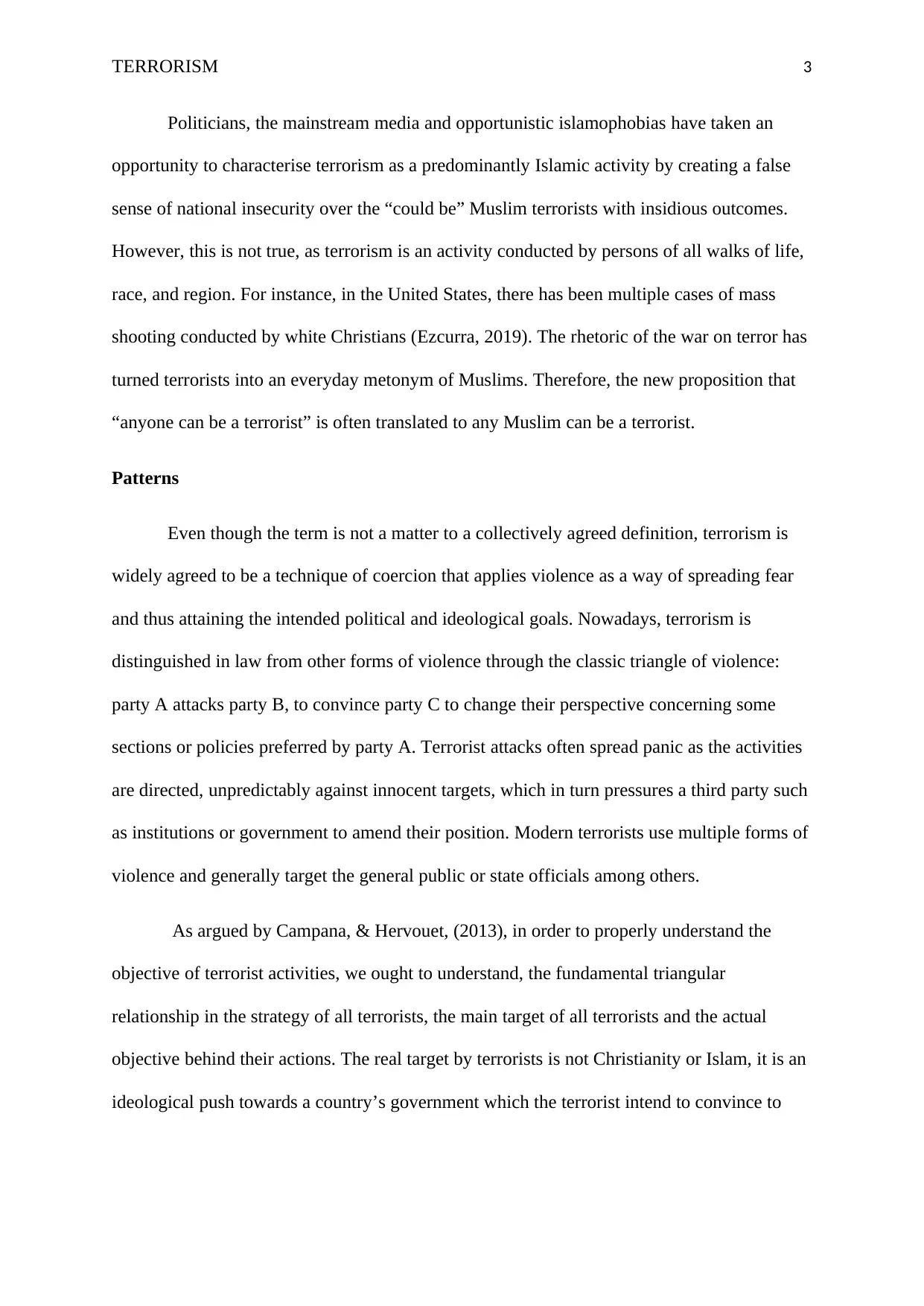
TERRORISM 3
Politicians, the mainstream media and opportunistic islamophobias have taken an
opportunity to characterise terrorism as a predominantly Islamic activity by creating a false
sense of national insecurity over the “could be” Muslim terrorists with insidious outcomes.
However, this is not true, as terrorism is an activity conducted by persons of all walks of life,
race, and region. For instance, in the United States, there has been multiple cases of mass
shooting conducted by white Christians (Ezcurra, 2019). The rhetoric of the war on terror has
turned terrorists into an everyday metonym of Muslims. Therefore, the new proposition that
“anyone can be a terrorist” is often translated to any Muslim can be a terrorist.
Patterns
Even though the term is not a matter to a collectively agreed definition, terrorism is
widely agreed to be a technique of coercion that applies violence as a way of spreading fear
and thus attaining the intended political and ideological goals. Nowadays, terrorism is
distinguished in law from other forms of violence through the classic triangle of violence:
party A attacks party B, to convince party C to change their perspective concerning some
sections or policies preferred by party A. Terrorist attacks often spread panic as the activities
are directed, unpredictably against innocent targets, which in turn pressures a third party such
as institutions or government to amend their position. Modern terrorists use multiple forms of
violence and generally target the general public or state officials among others.
As argued by Campana, & Hervouet, (2013), in order to properly understand the
objective of terrorist activities, we ought to understand, the fundamental triangular
relationship in the strategy of all terrorists, the main target of all terrorists and the actual
objective behind their actions. The real target by terrorists is not Christianity or Islam, it is an
ideological push towards a country’s government which the terrorist intend to convince to
Politicians, the mainstream media and opportunistic islamophobias have taken an
opportunity to characterise terrorism as a predominantly Islamic activity by creating a false
sense of national insecurity over the “could be” Muslim terrorists with insidious outcomes.
However, this is not true, as terrorism is an activity conducted by persons of all walks of life,
race, and region. For instance, in the United States, there has been multiple cases of mass
shooting conducted by white Christians (Ezcurra, 2019). The rhetoric of the war on terror has
turned terrorists into an everyday metonym of Muslims. Therefore, the new proposition that
“anyone can be a terrorist” is often translated to any Muslim can be a terrorist.
Patterns
Even though the term is not a matter to a collectively agreed definition, terrorism is
widely agreed to be a technique of coercion that applies violence as a way of spreading fear
and thus attaining the intended political and ideological goals. Nowadays, terrorism is
distinguished in law from other forms of violence through the classic triangle of violence:
party A attacks party B, to convince party C to change their perspective concerning some
sections or policies preferred by party A. Terrorist attacks often spread panic as the activities
are directed, unpredictably against innocent targets, which in turn pressures a third party such
as institutions or government to amend their position. Modern terrorists use multiple forms of
violence and generally target the general public or state officials among others.
As argued by Campana, & Hervouet, (2013), in order to properly understand the
objective of terrorist activities, we ought to understand, the fundamental triangular
relationship in the strategy of all terrorists, the main target of all terrorists and the actual
objective behind their actions. The real target by terrorists is not Christianity or Islam, it is an
ideological push towards a country’s government which the terrorist intend to convince to
⊘ This is a preview!⊘
Do you want full access?
Subscribe today to unlock all pages.

Trusted by 1+ million students worldwide
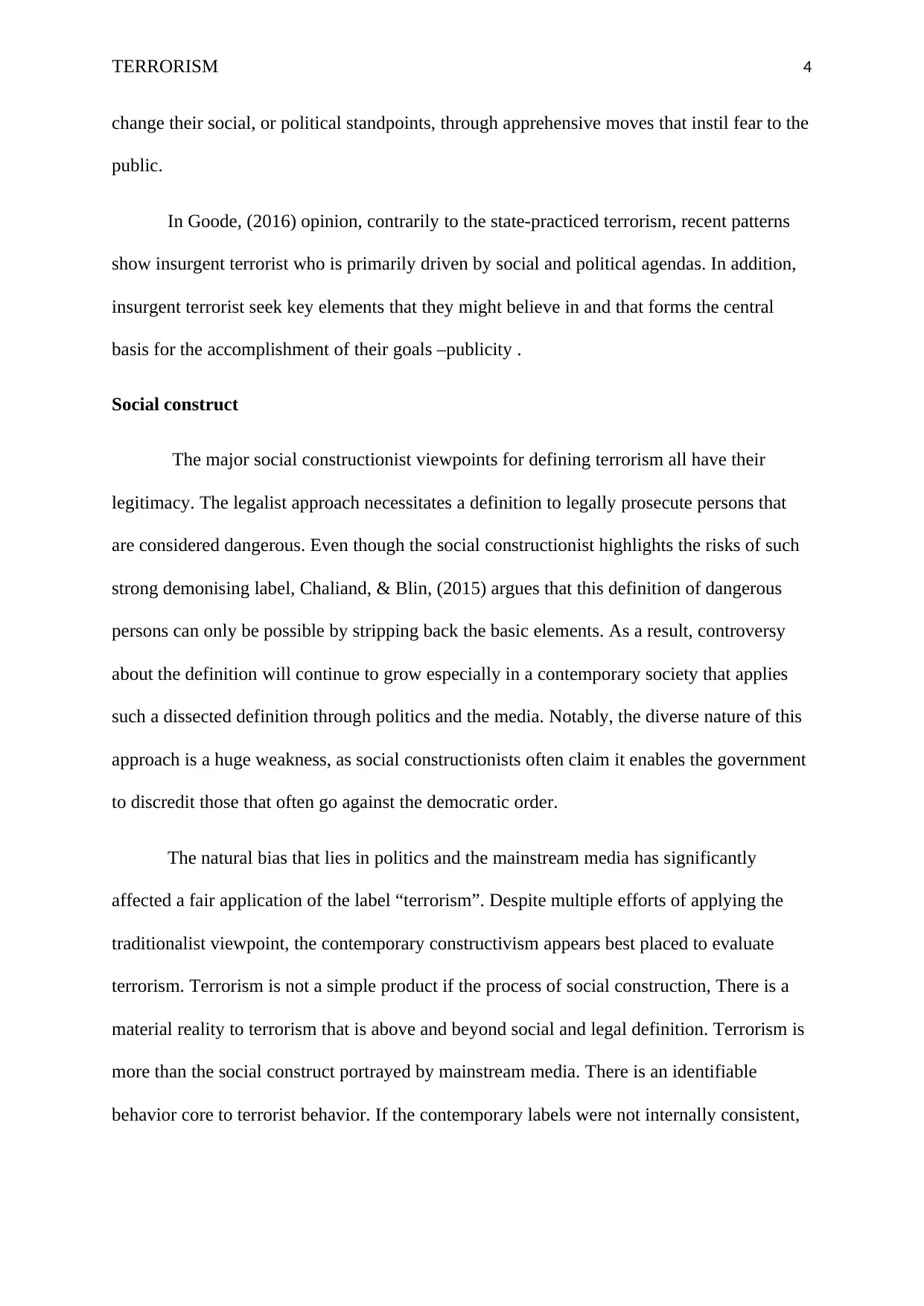
TERRORISM 4
change their social, or political standpoints, through apprehensive moves that instil fear to the
public.
In Goode, (2016) opinion, contrarily to the state-practiced terrorism, recent patterns
show insurgent terrorist who is primarily driven by social and political agendas. In addition,
insurgent terrorist seek key elements that they might believe in and that forms the central
basis for the accomplishment of their goals –publicity .
Social construct
The major social constructionist viewpoints for defining terrorism all have their
legitimacy. The legalist approach necessitates a definition to legally prosecute persons that
are considered dangerous. Even though the social constructionist highlights the risks of such
strong demonising label, Chaliand, & Blin, (2015) argues that this definition of dangerous
persons can only be possible by stripping back the basic elements. As a result, controversy
about the definition will continue to grow especially in a contemporary society that applies
such a dissected definition through politics and the media. Notably, the diverse nature of this
approach is a huge weakness, as social constructionists often claim it enables the government
to discredit those that often go against the democratic order.
The natural bias that lies in politics and the mainstream media has significantly
affected a fair application of the label “terrorism”. Despite multiple efforts of applying the
traditionalist viewpoint, the contemporary constructivism appears best placed to evaluate
terrorism. Terrorism is not a simple product if the process of social construction, There is a
material reality to terrorism that is above and beyond social and legal definition. Terrorism is
more than the social construct portrayed by mainstream media. There is an identifiable
behavior core to terrorist behavior. If the contemporary labels were not internally consistent,
change their social, or political standpoints, through apprehensive moves that instil fear to the
public.
In Goode, (2016) opinion, contrarily to the state-practiced terrorism, recent patterns
show insurgent terrorist who is primarily driven by social and political agendas. In addition,
insurgent terrorist seek key elements that they might believe in and that forms the central
basis for the accomplishment of their goals –publicity .
Social construct
The major social constructionist viewpoints for defining terrorism all have their
legitimacy. The legalist approach necessitates a definition to legally prosecute persons that
are considered dangerous. Even though the social constructionist highlights the risks of such
strong demonising label, Chaliand, & Blin, (2015) argues that this definition of dangerous
persons can only be possible by stripping back the basic elements. As a result, controversy
about the definition will continue to grow especially in a contemporary society that applies
such a dissected definition through politics and the media. Notably, the diverse nature of this
approach is a huge weakness, as social constructionists often claim it enables the government
to discredit those that often go against the democratic order.
The natural bias that lies in politics and the mainstream media has significantly
affected a fair application of the label “terrorism”. Despite multiple efforts of applying the
traditionalist viewpoint, the contemporary constructivism appears best placed to evaluate
terrorism. Terrorism is not a simple product if the process of social construction, There is a
material reality to terrorism that is above and beyond social and legal definition. Terrorism is
more than the social construct portrayed by mainstream media. There is an identifiable
behavior core to terrorist behavior. If the contemporary labels were not internally consistent,
Paraphrase This Document
Need a fresh take? Get an instant paraphrase of this document with our AI Paraphraser
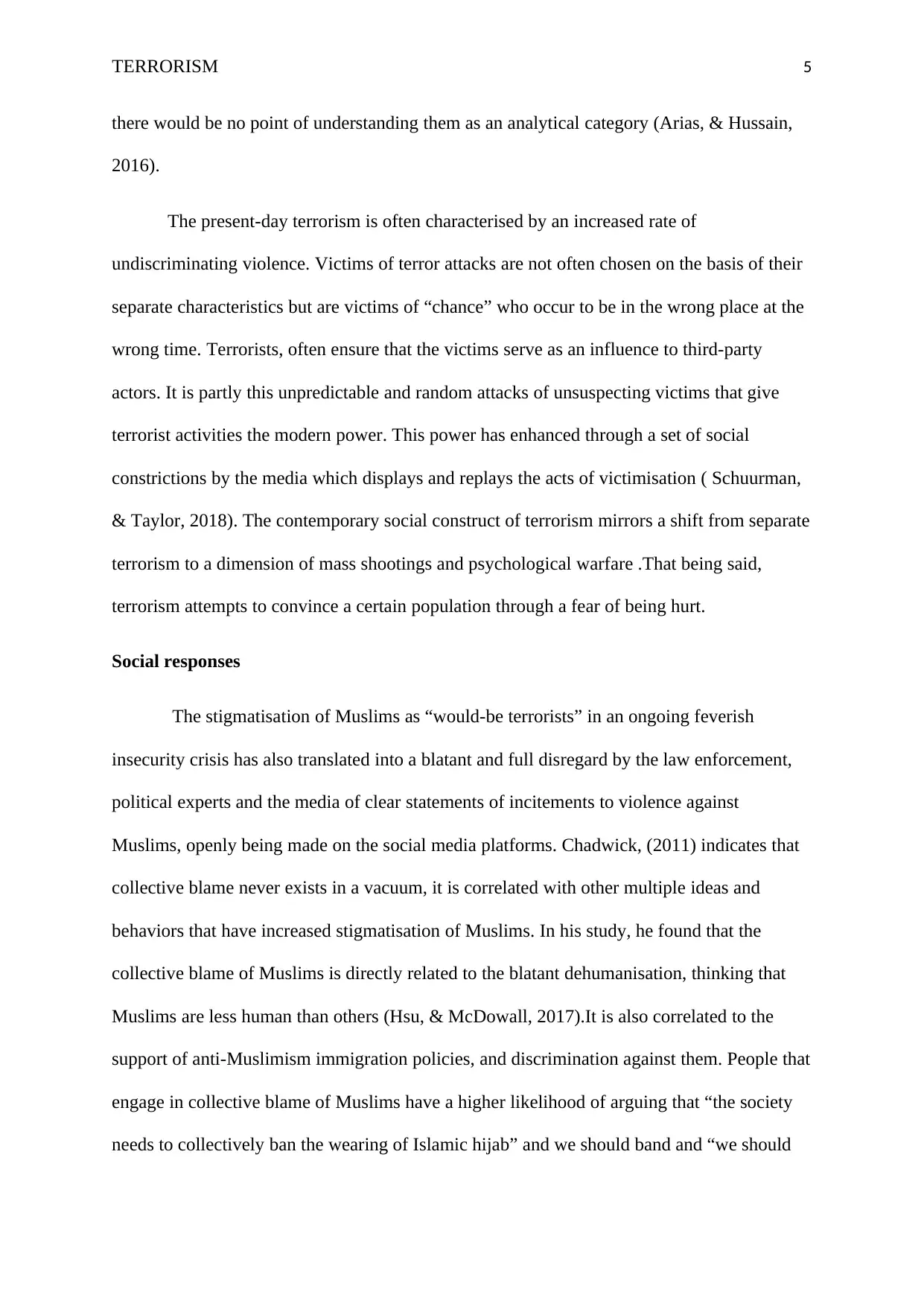
TERRORISM 5
there would be no point of understanding them as an analytical category (Arias, & Hussain,
2016).
The present-day terrorism is often characterised by an increased rate of
undiscriminating violence. Victims of terror attacks are not often chosen on the basis of their
separate characteristics but are victims of “chance” who occur to be in the wrong place at the
wrong time. Terrorists, often ensure that the victims serve as an influence to third-party
actors. It is partly this unpredictable and random attacks of unsuspecting victims that give
terrorist activities the modern power. This power has enhanced through a set of social
constrictions by the media which displays and replays the acts of victimisation ( Schuurman,
& Taylor, 2018). The contemporary social construct of terrorism mirrors a shift from separate
terrorism to a dimension of mass shootings and psychological warfare .That being said,
terrorism attempts to convince a certain population through a fear of being hurt.
Social responses
The stigmatisation of Muslims as “would-be terrorists” in an ongoing feverish
insecurity crisis has also translated into a blatant and full disregard by the law enforcement,
political experts and the media of clear statements of incitements to violence against
Muslims, openly being made on the social media platforms. Chadwick, (2011) indicates that
collective blame never exists in a vacuum, it is correlated with other multiple ideas and
behaviors that have increased stigmatisation of Muslims. In his study, he found that the
collective blame of Muslims is directly related to the blatant dehumanisation, thinking that
Muslims are less human than others (Hsu, & McDowall, 2017).It is also correlated to the
support of anti-Muslimism immigration policies, and discrimination against them. People that
engage in collective blame of Muslims have a higher likelihood of arguing that “the society
needs to collectively ban the wearing of Islamic hijab” and we should band and “we should
there would be no point of understanding them as an analytical category (Arias, & Hussain,
2016).
The present-day terrorism is often characterised by an increased rate of
undiscriminating violence. Victims of terror attacks are not often chosen on the basis of their
separate characteristics but are victims of “chance” who occur to be in the wrong place at the
wrong time. Terrorists, often ensure that the victims serve as an influence to third-party
actors. It is partly this unpredictable and random attacks of unsuspecting victims that give
terrorist activities the modern power. This power has enhanced through a set of social
constrictions by the media which displays and replays the acts of victimisation ( Schuurman,
& Taylor, 2018). The contemporary social construct of terrorism mirrors a shift from separate
terrorism to a dimension of mass shootings and psychological warfare .That being said,
terrorism attempts to convince a certain population through a fear of being hurt.
Social responses
The stigmatisation of Muslims as “would-be terrorists” in an ongoing feverish
insecurity crisis has also translated into a blatant and full disregard by the law enforcement,
political experts and the media of clear statements of incitements to violence against
Muslims, openly being made on the social media platforms. Chadwick, (2011) indicates that
collective blame never exists in a vacuum, it is correlated with other multiple ideas and
behaviors that have increased stigmatisation of Muslims. In his study, he found that the
collective blame of Muslims is directly related to the blatant dehumanisation, thinking that
Muslims are less human than others (Hsu, & McDowall, 2017).It is also correlated to the
support of anti-Muslimism immigration policies, and discrimination against them. People that
engage in collective blame of Muslims have a higher likelihood of arguing that “the society
needs to collectively ban the wearing of Islamic hijab” and we should band and “we should
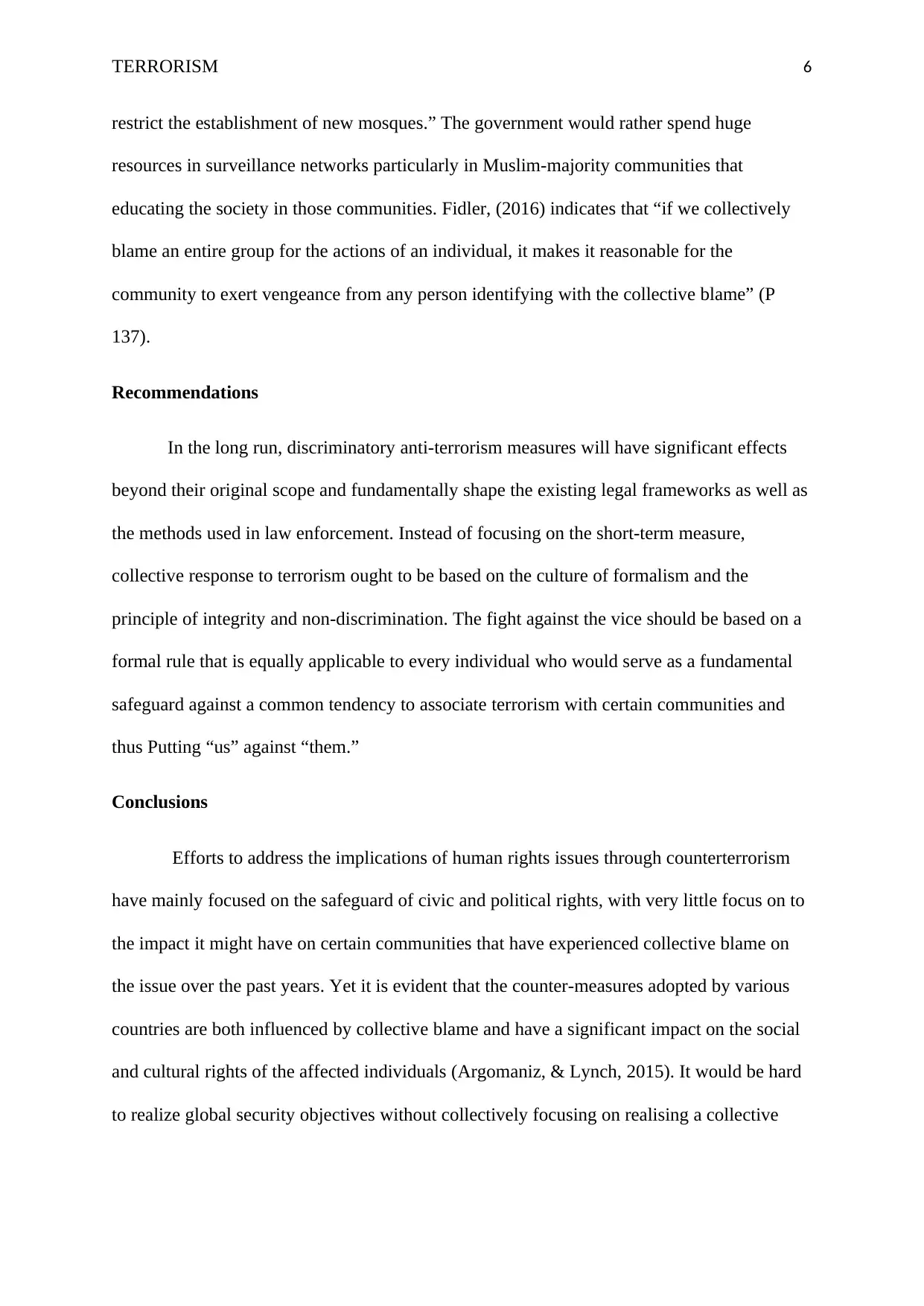
TERRORISM 6
restrict the establishment of new mosques.” The government would rather spend huge
resources in surveillance networks particularly in Muslim-majority communities that
educating the society in those communities. Fidler, (2016) indicates that “if we collectively
blame an entire group for the actions of an individual, it makes it reasonable for the
community to exert vengeance from any person identifying with the collective blame” (P
137).
Recommendations
In the long run, discriminatory anti-terrorism measures will have significant effects
beyond their original scope and fundamentally shape the existing legal frameworks as well as
the methods used in law enforcement. Instead of focusing on the short-term measure,
collective response to terrorism ought to be based on the culture of formalism and the
principle of integrity and non-discrimination. The fight against the vice should be based on a
formal rule that is equally applicable to every individual who would serve as a fundamental
safeguard against a common tendency to associate terrorism with certain communities and
thus Putting “us” against “them.”
Conclusions
Efforts to address the implications of human rights issues through counterterrorism
have mainly focused on the safeguard of civic and political rights, with very little focus on to
the impact it might have on certain communities that have experienced collective blame on
the issue over the past years. Yet it is evident that the counter-measures adopted by various
countries are both influenced by collective blame and have a significant impact on the social
and cultural rights of the affected individuals (Argomaniz, & Lynch, 2015). It would be hard
to realize global security objectives without collectively focusing on realising a collective
restrict the establishment of new mosques.” The government would rather spend huge
resources in surveillance networks particularly in Muslim-majority communities that
educating the society in those communities. Fidler, (2016) indicates that “if we collectively
blame an entire group for the actions of an individual, it makes it reasonable for the
community to exert vengeance from any person identifying with the collective blame” (P
137).
Recommendations
In the long run, discriminatory anti-terrorism measures will have significant effects
beyond their original scope and fundamentally shape the existing legal frameworks as well as
the methods used in law enforcement. Instead of focusing on the short-term measure,
collective response to terrorism ought to be based on the culture of formalism and the
principle of integrity and non-discrimination. The fight against the vice should be based on a
formal rule that is equally applicable to every individual who would serve as a fundamental
safeguard against a common tendency to associate terrorism with certain communities and
thus Putting “us” against “them.”
Conclusions
Efforts to address the implications of human rights issues through counterterrorism
have mainly focused on the safeguard of civic and political rights, with very little focus on to
the impact it might have on certain communities that have experienced collective blame on
the issue over the past years. Yet it is evident that the counter-measures adopted by various
countries are both influenced by collective blame and have a significant impact on the social
and cultural rights of the affected individuals (Argomaniz, & Lynch, 2015). It would be hard
to realize global security objectives without collectively focusing on realising a collective
⊘ This is a preview!⊘
Do you want full access?
Subscribe today to unlock all pages.

Trusted by 1+ million students worldwide
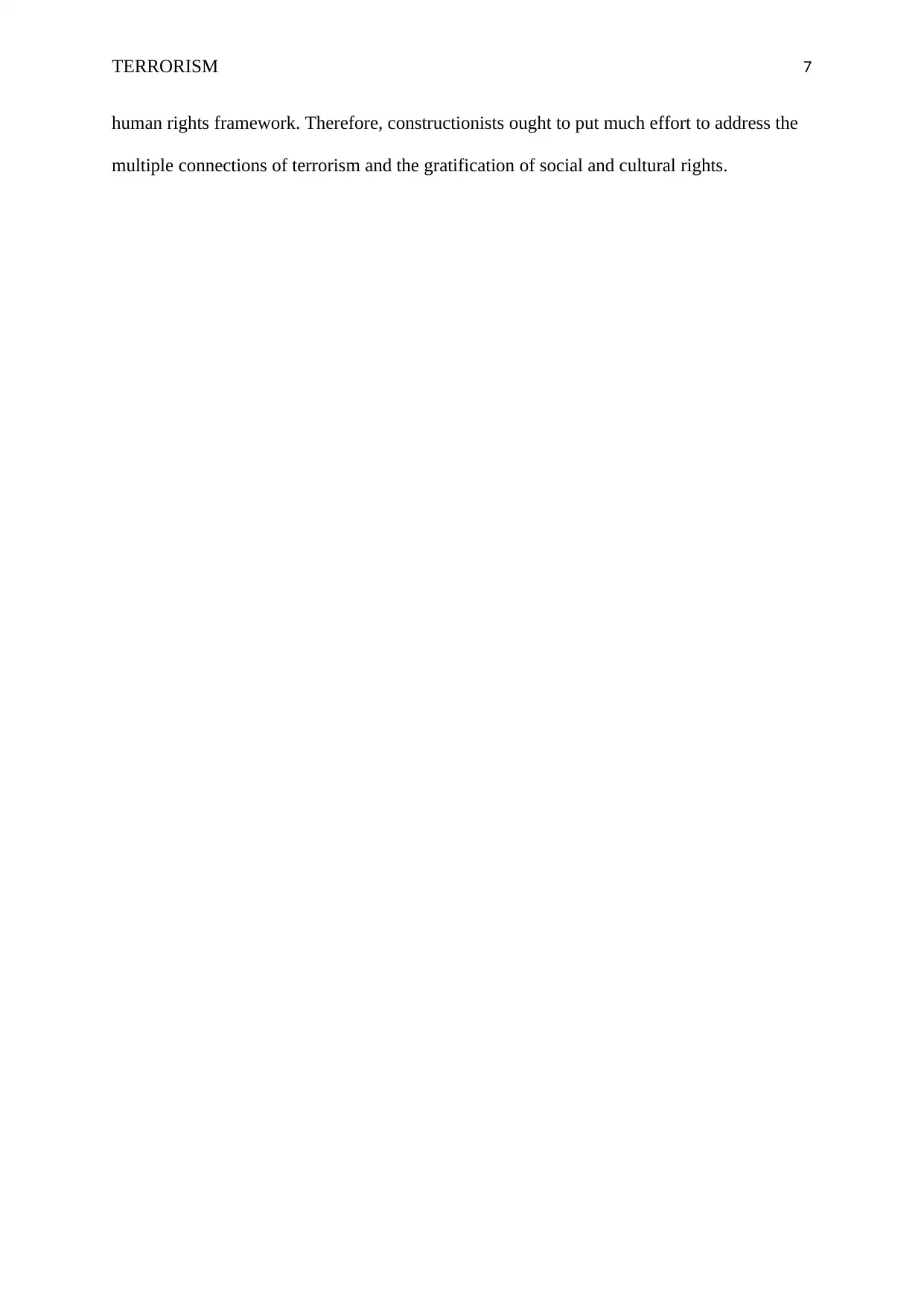
TERRORISM 7
human rights framework. Therefore, constructionists ought to put much effort to address the
multiple connections of terrorism and the gratification of social and cultural rights.
human rights framework. Therefore, constructionists ought to put much effort to address the
multiple connections of terrorism and the gratification of social and cultural rights.
Paraphrase This Document
Need a fresh take? Get an instant paraphrase of this document with our AI Paraphraser
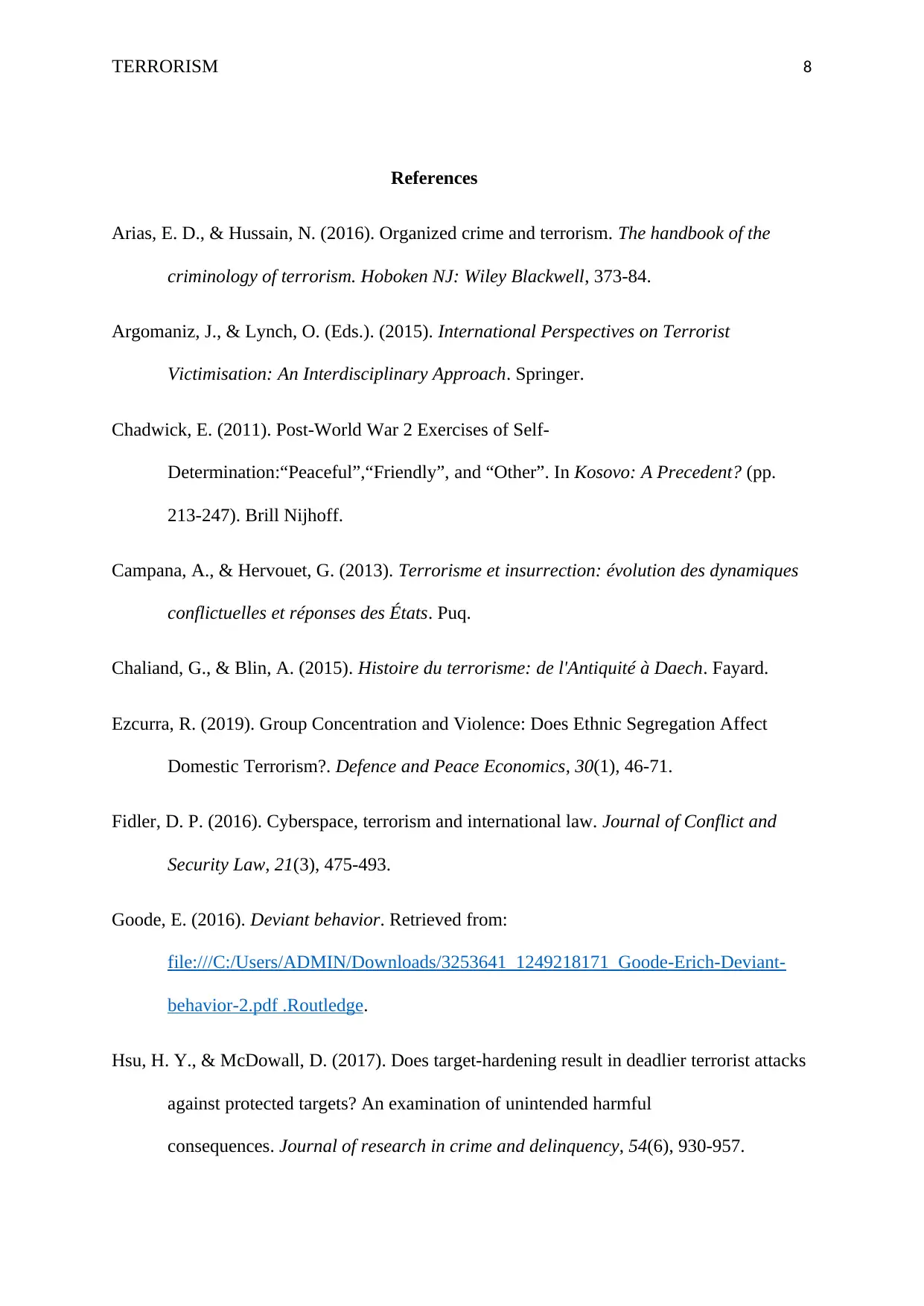
TERRORISM 8
References
Arias, E. D., & Hussain, N. (2016). Organized crime and terrorism. The handbook of the
criminology of terrorism. Hoboken NJ: Wiley Blackwell, 373-84.
Argomaniz, J., & Lynch, O. (Eds.). (2015). International Perspectives on Terrorist
Victimisation: An Interdisciplinary Approach. Springer.
Chadwick, E. (2011). Post-World War 2 Exercises of Self-
Determination:“Peaceful”,“Friendly”, and “Other”. In Kosovo: A Precedent? (pp.
213-247). Brill Nijhoff.
Campana, A., & Hervouet, G. (2013). Terrorisme et insurrection: évolution des dynamiques
conflictuelles et réponses des États. Puq.
Chaliand, G., & Blin, A. (2015). Histoire du terrorisme: de l'Antiquité à Daech. Fayard.
Ezcurra, R. (2019). Group Concentration and Violence: Does Ethnic Segregation Affect
Domestic Terrorism?. Defence and Peace Economics, 30(1), 46-71.
Fidler, D. P. (2016). Cyberspace, terrorism and international law. Journal of Conflict and
Security Law, 21(3), 475-493.
Goode, E. (2016). Deviant behavior. Retrieved from:
file:///C:/Users/ADMIN/Downloads/3253641_1249218171_Goode-Erich-Deviant-
behavior-2.pdf .Routledge.
Hsu, H. Y., & McDowall, D. (2017). Does target-hardening result in deadlier terrorist attacks
against protected targets? An examination of unintended harmful
consequences. Journal of research in crime and delinquency, 54(6), 930-957.
References
Arias, E. D., & Hussain, N. (2016). Organized crime and terrorism. The handbook of the
criminology of terrorism. Hoboken NJ: Wiley Blackwell, 373-84.
Argomaniz, J., & Lynch, O. (Eds.). (2015). International Perspectives on Terrorist
Victimisation: An Interdisciplinary Approach. Springer.
Chadwick, E. (2011). Post-World War 2 Exercises of Self-
Determination:“Peaceful”,“Friendly”, and “Other”. In Kosovo: A Precedent? (pp.
213-247). Brill Nijhoff.
Campana, A., & Hervouet, G. (2013). Terrorisme et insurrection: évolution des dynamiques
conflictuelles et réponses des États. Puq.
Chaliand, G., & Blin, A. (2015). Histoire du terrorisme: de l'Antiquité à Daech. Fayard.
Ezcurra, R. (2019). Group Concentration and Violence: Does Ethnic Segregation Affect
Domestic Terrorism?. Defence and Peace Economics, 30(1), 46-71.
Fidler, D. P. (2016). Cyberspace, terrorism and international law. Journal of Conflict and
Security Law, 21(3), 475-493.
Goode, E. (2016). Deviant behavior. Retrieved from:
file:///C:/Users/ADMIN/Downloads/3253641_1249218171_Goode-Erich-Deviant-
behavior-2.pdf .Routledge.
Hsu, H. Y., & McDowall, D. (2017). Does target-hardening result in deadlier terrorist attacks
against protected targets? An examination of unintended harmful
consequences. Journal of research in crime and delinquency, 54(6), 930-957.
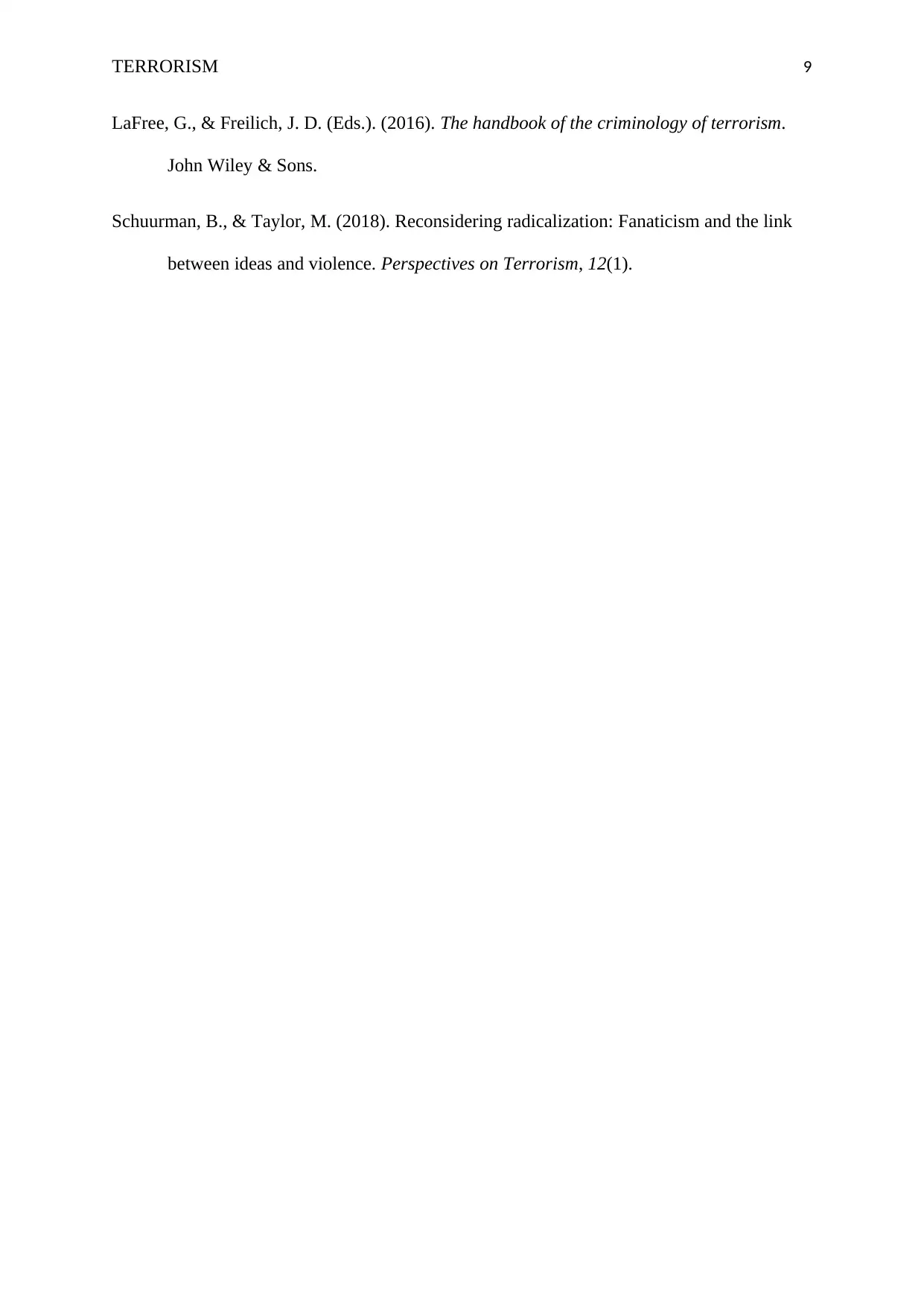
TERRORISM 9
LaFree, G., & Freilich, J. D. (Eds.). (2016). The handbook of the criminology of terrorism.
John Wiley & Sons.
Schuurman, B., & Taylor, M. (2018). Reconsidering radicalization: Fanaticism and the link
between ideas and violence. Perspectives on Terrorism, 12(1).
LaFree, G., & Freilich, J. D. (Eds.). (2016). The handbook of the criminology of terrorism.
John Wiley & Sons.
Schuurman, B., & Taylor, M. (2018). Reconsidering radicalization: Fanaticism and the link
between ideas and violence. Perspectives on Terrorism, 12(1).
⊘ This is a preview!⊘
Do you want full access?
Subscribe today to unlock all pages.

Trusted by 1+ million students worldwide
1 out of 9
Your All-in-One AI-Powered Toolkit for Academic Success.
+13062052269
info@desklib.com
Available 24*7 on WhatsApp / Email
![[object Object]](/_next/static/media/star-bottom.7253800d.svg)
Unlock your academic potential
Copyright © 2020–2025 A2Z Services. All Rights Reserved. Developed and managed by ZUCOL.

